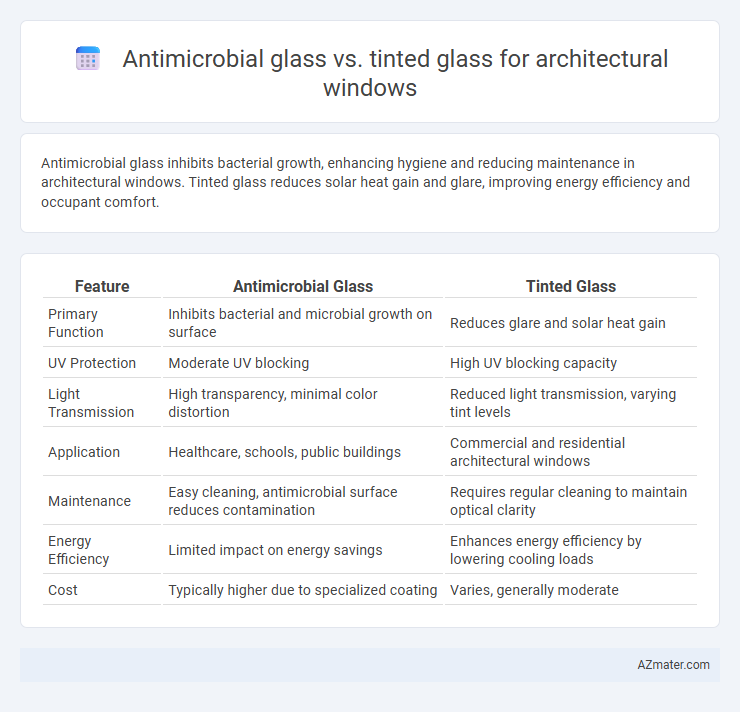Antimicrobial glass inhibits bacterial growth, enhancing hygiene and reducing maintenance in architectural windows. Tinted glass reduces solar heat gain and glare, improving energy efficiency and occupant comfort.
Table of Comparison
| Feature | Antimicrobial Glass | Tinted Glass |
|---|---|---|
| Primary Function | Inhibits bacterial and microbial growth on surface | Reduces glare and solar heat gain |
| UV Protection | Moderate UV blocking | High UV blocking capacity |
| Light Transmission | High transparency, minimal color distortion | Reduced light transmission, varying tint levels |
| Application | Healthcare, schools, public buildings | Commercial and residential architectural windows |
| Maintenance | Easy cleaning, antimicrobial surface reduces contamination | Requires regular cleaning to maintain optical clarity |
| Energy Efficiency | Limited impact on energy savings | Enhances energy efficiency by lowering cooling loads |
| Cost | Typically higher due to specialized coating | Varies, generally moderate |
Introduction to Architectural Glass Technologies
Antimicrobial glass incorporates advanced coatings that inhibit microbial growth, enhancing hygiene and safety in high-traffic or healthcare environments. Tinted glass reduces solar heat gain and glare, improving energy efficiency while providing privacy and UV protection in building facades. Both technologies address specific architectural needs, offering functional benefits that contribute to occupant comfort and building performance.
Understanding Antimicrobial Glass: Features and Benefits
Antimicrobial glass incorporates advanced coatings embedded with silver ions or copper particles that inhibit bacterial growth, providing enhanced hygiene and reducing surface contamination in architectural windows. This type of glass offers durable protection against microbes without compromising clarity or light transmission, making it ideal for high-traffic or healthcare environments. Unlike tinted glass, which primarily reduces glare and solar heat gain, antimicrobial glass actively promotes cleaner surfaces and improved indoor air quality.
Exploring Tinted Glass: Characteristics and Applications
Tinted glass, engineered with metal oxides or other additives, reduces solar heat gain and minimizes glare, enhancing energy efficiency in architectural windows. Its ability to absorb and reflect specific wavelengths contributes to improved occupant comfort and UV protection while maintaining visibility. Widely used in commercial and residential buildings, tinted glass offers diverse aesthetic options and supports sustainable building certifications like LEED.
Mechanisms of Germ Protection in Antimicrobial Glass
Antimicrobial glass incorporates surface coatings containing agents such as silver ions or copper nanoparticles that disrupt microbial cell membranes and inhibit reproduction, providing continuous germ protection. These coatings actively neutralize bacteria and viruses upon contact, preventing pathogen buildup and reducing cross-contamination risks in architectural windows. Tinted glass, by contrast, primarily offers solar heat control and UV protection without inherent antimicrobial properties or direct germ-killing mechanisms.
Solar Control and Energy Efficiency of Tinted Glass
Tinted glass enhances solar control by reducing heat gain through selective absorption of solar radiation, significantly lowering cooling loads and improving overall energy efficiency in buildings. Unlike antimicrobial glass, which primarily targets surface hygiene, tinted glass directly contributes to thermal regulation and daylight management, optimizing indoor comfort and reducing reliance on artificial cooling. Its ability to block substantial infrared and ultraviolet rays makes tinted glass a superior choice for architectural windows aiming to balance energy savings with occupant comfort.
Health and Safety Considerations in Glass Selection
Antimicrobial glass for architectural windows incorporates surface treatments that inhibit bacterial growth, reducing the risk of pathogen transmission in high-touch environments and enhancing overall indoor hygiene. Tinted glass primarily focuses on UV protection and glare reduction, but it does not provide direct antimicrobial benefits, which may be less effective in controlling surface-borne contaminants. Selecting antimicrobial glass supports health and safety by minimizing microbial accumulation, making it a superior option for hospitals, schools, and public buildings where hygiene is critical.
Aesthetic Differences: Visual Impact and Design Flexibility
Antimicrobial glass offers a clear, sleek appearance that enhances modern architectural designs by maintaining transparency while inhibiting microbial growth, making it ideal for high-contact areas requiring cleanliness without compromising light transmission. Tinted glass provides varied hues and shading options, reducing glare and solar heat gain, which allows architects to manipulate visual warmth and privacy levels more dynamically within a facade. The aesthetic differences hinge on antimicrobial glass prioritizing hygiene with minimal visual distortion, whereas tinted glass emphasizes color modulation and light control, granting broader design flexibility in both commercial and residential window applications.
Maintenance and Durability: Antimicrobial vs Tinted Glass
Antimicrobial glass features a specialized coating that inhibits bacterial growth, significantly reducing the need for frequent cleaning and lowering maintenance costs in architectural windows. Tinted glass, while effective in reducing glare and UV exposure, may show fingerprints and smudges more prominently, requiring regular upkeep to maintain clarity and appearance. In terms of durability, antimicrobial coatings are designed to withstand cleaning agents without degradation, whereas tinted glass durability depends on the quality of the tint application and can be prone to fading or peeling over time.
Cost Analysis and Long-term Value
Antimicrobial glass typically incurs higher upfront costs compared to tinted glass due to specialized coatings that inhibit microbial growth and enhance hygiene in architectural windows. Tinted glass offers cost-effective solar control by reducing heat gain and glare, potentially lowering energy expenses over time. Long-term value of antimicrobial glass includes reduced maintenance and improved indoor air quality, while tinted glass contributes to energy savings and occupant comfort, making cost-benefit analysis dependent on project priorities and environmental conditions.
Choosing the Right Glass: Recommendations for Architects
Antimicrobial glass offers enhanced hygiene by inhibiting bacterial growth, making it ideal for healthcare, schools, or high-traffic commercial buildings where sanitation is critical. Tinted glass provides superior solar control and reduces glare, improving energy efficiency and occupant comfort in office buildings or residential projects with significant sun exposure. Architects should evaluate project-specific requirements such as hygiene needs, energy goals, and aesthetic preferences to select the optimal glass type for architectural windows.

Infographic: Antimicrobial glass vs Tinted glass for Architectural window
 azmater.com
azmater.com